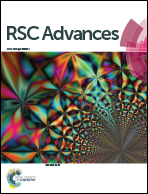Asymmetric fabric supercapacitor with a high areal energy density and excellent flexibility†
Abstract
Currently, there still remains a big challenge for flexible supercapacitors: low energy density. According to the equation E = (1/2)CU2, here we realize a combination of high gravimetric specific capacitances of active materials, high mass loadings of active materials and a large voltage window, which results in the highest areal energy density to the best of our knowledge. Specifically, a cotton fabric was tuned to have an optimal pore structure, on which CNT/rGO and PPy were coated by dip-coating and chemical polymerization, respectively. The mass loading of CNT/rGO is up to 7.7 mg cm−2, to balance which the PPy has a mass loading of 5.7 mg cm−2. The resulting asymmetric supercapacitor with a voltage window of 1.8 V exhibits a super-high areal energy density of 0.26 mW h cm−2. Moreover, it possesses excellent stability under charge/discharge for 1000 cycles and under bending 100 times with an angle of 180°.



 Please wait while we load your content...
Please wait while we load your content...